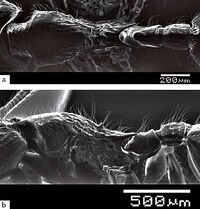Myrmecina elegans
| Myrmecina elegans | |
|---|---|

| |
| Scientific classification | |
| Kingdom: | Animalia |
| Phylum: | Arthropoda |
| Class: | Insecta |
| Order: | Hymenoptera |
| Family: | Formicidae |
| Subfamily: | Myrmicinae |
| Tribe: | Crematogastrini |
| Genus: | Myrmecina |
| Species: | M. elegans |
| Binomial name | |
| Myrmecina elegans Okido, Ogata & Hosoishsi, 2020 | |
Nothing is known about the biology of Myrmecina elegans.
Identification
Okido, Ogata, and Hosoishi (2020) - Myrmecina elegans does not belong to any species complex . But M. elegans is similar to Myrmecina aspera on the basis of some characters (see the remarks of M. aspera). Among those species, M. elegans can be distinguished from the remains by having the elongate propodeal spine, the smooth and shining dorsum of the pronotum, and the eye comprising 10 ommatidia or less.
Keys including this Species
Distribution
Distribution based on Regional Taxon Lists
Indo-Australian Region: Malaysia (type locality).
Distribution based on AntMaps
Distribution based on AntWeb specimens
Check data from AntWeb
Countries Occupied
| Number of countries occupied by this species based on AntWiki Regional Taxon Lists. In general, fewer countries occupied indicates a narrower range, while more countries indicates a more widespread species. |

|
Biology
Castes
Nomenclature
The following information is derived from Barry Bolton's Online Catalogue of the Ants of the World.
- elegans. Myrmecina elegans Okido, Ogata & Hosoishsi, 2020: 38, fig. 15 (w.) MALAYSIA.
Unless otherwise noted the text for the remainder of this section is reported from the publication that includes the original description.
Description
Worker
Holotype. TL 3.42, HL 0.84, HW 0.72, CI 86, SL 0.69, SI 96, PW 0.48, ML 0.94.
Head subrectangular, longer than broad in full-face view; median portion of occipital margin concave; occipital corners rounded, not projected posteriorly. Masticatory margin of mandible bent at midlength (third small tooth or sixth tooth); apical tooth strong, third tooth robust, followed by 5 small teeth. Dorsal surface of clypeus concave; median portion of anterior margin slightly projected with a median process or three processes; lateral portion simple, lacking sharp ridge in front of antennal insertions. Anterior dorsal surface of labrum with paired small denticles, which are relatively well separated. Frontal carinae virtually absent, indistinguishable from rugae on dorsum of head. Eyes extremely small circularly and moderately convex with maximum diameter 0.06 mm, with 8 ommatidia; malar space distinctly twice as long as diameter of eye or longer in profile; distance between occipital margin and posterior margin of eye distinctly four times as long as diameter of eye or longer. Antennal scape short, just reaching posterolateral corner of head; antennal flange fully developed.
Mesosoma slender in profile. Pronotum without denticles on anterior dorsolateral portion; anterior portion not marginate; anterior ventrolateral portion not angulate. Mesoepisternal projection much reduced; furrow between pronotum and mesoepisternal projection broad. Eumetanotal spine present. Propodeal spine elongate, much longer than broad at base, extending over vertical posteriormost limit of propodeum in profile. Propodeal lobe low. Propodeal spiracle large, situated near base of propodeal spine, distance between posterior margin of spiracle and posterior margin of propodeum longer than diameter of spiracle. Petiole long, longer than high in profile, and much longer than broad in dorsal view; dorsal crest located at midlength in profile; subpetiolar process present, bearing acute anterior apex. Postpetiole expanded posteriorly as broad as petiole in dorsal view; dorsal outline flattened in profile; ventral outline slightly projected rectangularly without acute anterior apex.
Anterior margin of gaster slightly concave in dorsal view; first gastral sternum simple without median longitudinal ridge.
Head with irregular rugae which are thin; ventrolateral portion smooth and shining. Clypeus smooth and shining. Mesosoma feebly sculptured, but almost smooth and shining. Forecoxa smooth and shining. Petiole and postpetiole smooth and shining. First gastral segment smooth and shining. Head with dense and long pilosity on dorsum. Mesosoma with dense and long pilosity on dorsum, hairs of pronotum slightly shorter than propodeal spine. Petiole with 2 hairs on ventral surface. Postpetiole with 8 hairs on ventral surface. Body yellowish brown.
Type Material
Holotype worker, MALAYSIA: Sabah, Kinabalu, 1880 m, 26. iv. 87 (Burckhardt & Löbl) (The Natural History Museum).
